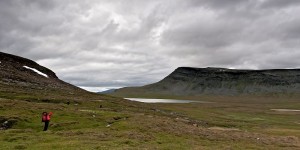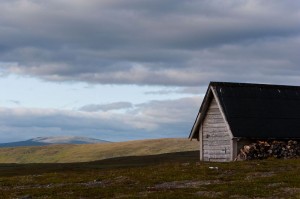
There are no public toilets in Kongsfjord in Northern Norway. At least there were none in the late 1960’s or early 70’s. At about the same time as I discovered that interesting piece of trivia I also learned that there are main roads you can travel on where the few road signs only have place names for towns in the opposite direction to which you are travelling. You gradually realize that that the nearest place with a name is getting farther and farther from you as you go. Common sense tells you that where there is a road, there must be a reason at the end of it, but it is hard to fight the evidence of the signs on this lonely highway in the Arctic Circle on the way to the shores of the Barents Sea.
Not long after my experience with the lemmings in Northern Lapland I found myself on just such a road, in a transport truck, hitching a ride to one of the the northernmost points of Norway, a small fishing town, Kongsfjord. The truck driver was on his way to this lonely outpost to pick up a cargo of frozen fish skins and waste for transport to the mink farms in the South of Finland.
On this journey I finally made first hand acquaintance with a school geography lesson phenomenon – the ‘Tree Line’. That expression is bandied about in geography class and was familiar to me as a Canadian school child. Somehow I imagined that it was a term that described an area of few trees, or low trees over a stretch of land, or even a particular delineation that marked some boundary in the Northern regions.
As the truck drove us further into the Arctic circle, I realised that the tree line is all of those. At a distance it is a clearly defined line of trees that marches across the terrain before starkly disrobing to reveal the barren tundra. Closer up you see that the progression is mostly gradual, from normal to stunted and weathered through to the point where they simply stop growing. The line it makes gives an unexpected strong sense of finality. From this point on there will be no more trees. I was astonished at the literal view of what had been to me a mythical term.
Kongsfjord is over 300 kms from Ivalo, Finnish Lapland. At that time of year the whole trip took place in daylight and with no logical progression of light to dark, time on the journey had a surreal sense of standing still.

The starkly beautiful tundra landscape spread all around and before us as far as we could see broken only by the occasional stream or lake and, now and again, a lonely wooden building.
We pulled into Kongsfjord and the truck driver parked in the dark loading bay of the fish packing plant on the wharf. As he opened his door he was instantly surrounded by coated, furtive figures who thrust out their fists towards him, waving wads of bills. Little was said (I’m not sure any of them understood Finnish) but their meaning was unmistakable.
You could not buy alcohol in this town. I can’t recall the reason (no state licensed liquor store perhaps?) but the fact made the commodity more valuable than gold. The driver had a nice little sideline in bootleg alcohol sales and he was for that short time the most popular man in that part of the world.
While the truck was loaded with the huge blocks of frozen fish skins I walked around the little town and sat on the rocks overlooking Kongsfjord bay. A single horse wandered freely through the streets and around the houses. There were no fences. Why would there be? Where would he possibly want to go? The first impression was one of a wonderful sense of freedom but at the same time the overwhelming knowledge that he would not have survived for long in that wilderness. His fence was everywhere.

I knew that we would be heading back down the road again soon, so began to look for a public toilet. There were none. What was I to do? There were obviously no trees or bushes so that was out. Everywhere was horribly exposed to view. I decided that I would have to approach one of the houses and ask if I could use theirs.
My first few knocks went unanswered. Finally at the 4th house a lady in a dressing gown came to the door. Too late I realized that it was the middle of the night. (Curse the eternal daylight and lack of a watch.) She smiled at me however and I asked in my clearest English if I could use her washroom. She kept smiling. How stupid of me to think she would understand me. Now what? It was getting more urgent by the minute. I tried all expressions I could think of: WC, VC (Finnish language does not use the W but substitutes a V), toilet, toiletten. Nothing meant anything to her. Finally in desperation I mimed what it was I needed to do. Her face lit up and the smile widened and I was invited inside to use her facilities. Without being able to understand a thing I said, she insisted on making me a sandwich and coffee that I was grateful to eat before I left.
I see now from Google Maps images (how is that possible?) that there is a small museum cafe in the town. Clearly there are now more reasons to visit this remote corner of the world than to collect fish skins or sell whisky. Maybe there are now some public toilets. Remember to take your watch in case there are none.
